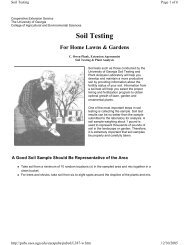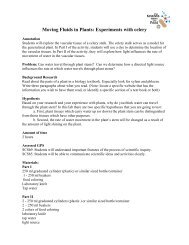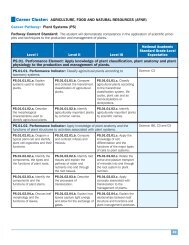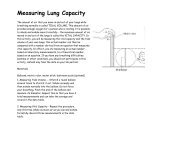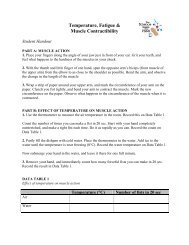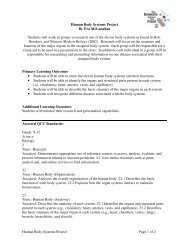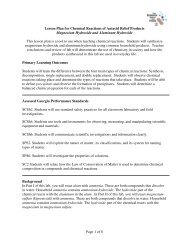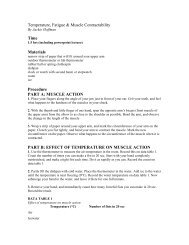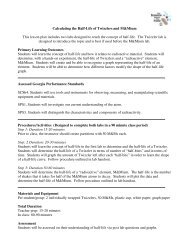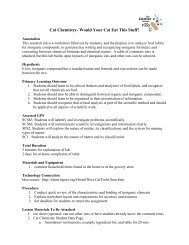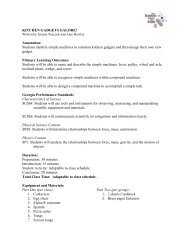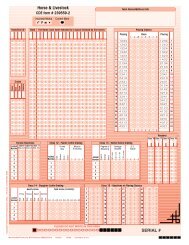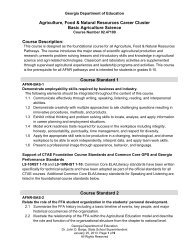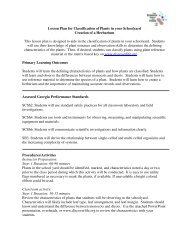From âDesigner Jeansâ to âDesigner Genesâ An Analysis of the Use ...
From âDesigner Jeansâ to âDesigner Genesâ An Analysis of the Use ...
From âDesigner Jeansâ to âDesigner Genesâ An Analysis of the Use ...
Create successful ePaper yourself
Turn your PDF publications into a flip-book with our unique Google optimized e-Paper software.
<strong>From</strong> “Designer Jeans” <strong>to</strong> “Designer Genes”<br />
<strong>An</strong> <strong>An</strong>alysis <strong>of</strong> <strong>the</strong> <strong>Use</strong> <strong>of</strong><br />
Biotechnology in Society Today<br />
Written by Jackie H<strong>of</strong>fman<br />
** Note: This lesson plan was adapted from a Genetic Engineering lesson plan posted on<br />
http://school.discovery.com<br />
<strong>An</strong>notation:<br />
This lesson will enable students <strong>to</strong> discover ethical issues surrounding <strong>the</strong> practice <strong>of</strong> genetic<br />
engineering in reproductive medicine and understand key terms and concepts related <strong>to</strong> <strong>the</strong><br />
science <strong>of</strong> genetic engineering.<br />
Primary Learning Outcome:<br />
Students should understand <strong>the</strong> role <strong>of</strong> ethics in science, evaluate <strong>the</strong> use <strong>of</strong> technology <strong>to</strong> create<br />
“designer babies,” assess pros and cons <strong>of</strong> such genetic manipulation, and become aware <strong>of</strong><br />
what types <strong>of</strong> stem cell research, cloning, and genetic advancements are currently taking place in<br />
<strong>the</strong> scientific community.<br />
Assessed GPS:<br />
SB2. Students will analyze how biological traits are passed on <strong>to</strong> successive generations.<br />
a. Distinguish between DNA and RNA.<br />
b. Explain <strong>the</strong> role <strong>of</strong> DNA in s<strong>to</strong>ring and transmitting cellular information.<br />
SCSh6. Students will communicate scientific investigations and information clearly.<br />
b. Write clear, coherent accounts <strong>of</strong> current scientific issues, including possible<br />
alternative interpretations <strong>of</strong> <strong>the</strong> data.<br />
d. Participate in group discussions <strong>of</strong> scientific investigation and current scientific<br />
issues.<br />
f. Examine <strong>the</strong> use <strong>of</strong> DNA technology in forensics, medicine, and agriculture.<br />
SCSh9. Students will enhance reading in all curriculum areas by:<br />
a. Reading in all curriculum areas<br />
• Read a minimum <strong>of</strong> 25 grade-level appropriate books per year from a variety <strong>of</strong><br />
subject disciplines and participate in discussions related <strong>to</strong> curricular learning in<br />
all areas.<br />
• Read both informational and fictional texts in a variety <strong>of</strong> genres and modes <strong>of</strong><br />
discourse.<br />
• Read technical texts related <strong>to</strong> various subject areas.<br />
Materials:<br />
1) Designer Babies Video (# 764647) (http://shopping.discovery.com/s<strong>to</strong>res)<br />
2) A class set <strong>of</strong> <strong>the</strong> novel A Brave New World by Aldous Huxley<br />
3) Computer with Internet access (optional)<br />
4) Library resources for research<br />
5) Paper, pens, pencils
Total Duration:<br />
Day 1- 1.5 hrs<br />
Day 2- 1.5 hrs<br />
** If reading assignment is included, plan for ~ 20 minutes <strong>of</strong> discussion per day for <strong>the</strong> two<br />
week duration when students are reading Aldous Huxley’s A Brave New World<br />
Procedures:<br />
Step 1<br />
Description: Designer Babies Video (52 minutes), remainder <strong>of</strong> <strong>the</strong> class period will be used for<br />
discussion and assignment “Different Perspectives on Genetic Engineering.” Reading schedule<br />
for “A Brave New World” by Aldous Huxley will be assigned for ~ two week duration.<br />
Duration in hours/minutes: Day 1- 1.5 hrs.<br />
Discussion: In groups have students analyze <strong>the</strong> risks and benefits associated with<br />
biotechnology. For example, <strong>the</strong> removal <strong>of</strong> hemophilia or o<strong>the</strong>r serious disorders from <strong>the</strong> gene<br />
pool is a benefit because people would no longer suffer from a chronic condition. <strong>An</strong> example <strong>of</strong><br />
a risk is going <strong>to</strong>o far in selecting <strong>the</strong> genetic makeup <strong>of</strong> future children.<br />
Possible risks:<br />
• Relying on eugenics, or selecting <strong>the</strong> genetic makeup <strong>of</strong> future children. This practice<br />
may give people <strong>the</strong> power <strong>to</strong> control some personal traits, such as having blond hair or<br />
being tall. Taken <strong>to</strong> an extreme, this could eliminate some traits.<br />
• Using biotechnology before exploring o<strong>the</strong>r options, particularly in reproductive<br />
medicine. For example, technology enables scientists <strong>to</strong> implant an egg from one woman<br />
in<strong>to</strong> <strong>the</strong> uterus <strong>of</strong> ano<strong>the</strong>r. But it may not be a good idea <strong>to</strong> use this technique before<br />
trying less extreme techniques first.<br />
Possible benefits:<br />
• Eliminating genetic diseases. For example, geneticists think it may be possible <strong>to</strong><br />
eliminate genetic diseases such as Tay-Sachs through careful and methodical screening<br />
programs.<br />
• Screening unborn babies. This refers <strong>to</strong> screening for genetic disorders ei<strong>the</strong>r before a<br />
pregnancy takes place or in <strong>the</strong> early months <strong>of</strong> a pregnancy. More information would<br />
give prospective parents more options in dealing with <strong>the</strong>ir infants’ problems.<br />
• Treating diseases. For example, scientists are working on ways <strong>to</strong> insert cells from<br />
embryos in<strong>to</strong> cancerous cells as a way <strong>to</strong> s<strong>to</strong>p <strong>the</strong> growth <strong>of</strong> cancer.<br />
Step 2<br />
Description: Research and <strong>An</strong>alysis <strong>of</strong> Ethics Involved in Genetic Engineering<br />
Duration in hours/minutes: Day 2- 1.5 hrs.<br />
Allow students <strong>to</strong> conduct research in order <strong>to</strong> gain background information so that <strong>the</strong>y can<br />
answer <strong>the</strong> following questions: (** Note: It might be beneficial <strong>to</strong> allow students <strong>to</strong> work in<br />
pairs <strong>to</strong> answer and discuss <strong>the</strong>se questions).
1) Discuss issues involved with biotechnology and reproductive medicine. For example, <strong>the</strong><br />
technology may allow a 60-year-old woman <strong>to</strong> have a<br />
baby. Is that a positive or negative outcome? Consider its ramifications. How does this<br />
example illustrate some <strong>of</strong> <strong>the</strong> complex issues that arise<br />
from <strong>the</strong> use <strong>of</strong> biotechnology?<br />
2) Discuss ways in which biotechnology is becoming a powerful presence in our lives. What<br />
areas have been affected by biotechnology? Give at<br />
least two examples.<br />
3) What safeguards must society adopt <strong>to</strong> handle <strong>the</strong> rapid advances in biotechnology?<br />
4) To what extent should religious ideology influence bioethics? To what extent should a<br />
religious perspective affect <strong>the</strong> use <strong>of</strong> biotechnology?<br />
5) What are some positive long-term effects <strong>of</strong> biotechnology? What are some negative<br />
long-term effects?<br />
6) During World War II, Nazis in Germany conducted experiments <strong>to</strong> selectively breed<br />
blond, blue-eyed men and women. This is an example <strong>of</strong><br />
eugenics that was detrimental <strong>to</strong> society. Explain why.<br />
Step 3<br />
Description: Reading <strong>of</strong> Alexus Hudley’s A Brave New World and Comparison Paper<br />
Duration in hours/minutes: Ongoing Project (~ two week duration with 10-20 minute discussions<br />
each day; may vary depending upon class schedule)<br />
Student will read this novel independently and will discuss <strong>the</strong> novel as a class for approximately<br />
10-20 minutes per day for <strong>the</strong> duration <strong>of</strong> two weeks or so. Students will be asked <strong>to</strong> write a<br />
comparison paper on <strong>the</strong> novel Brave New World, by Aldous Huxley (1932) that compares and<br />
contrasts <strong>the</strong> ethical and societal conflicts in Huxley’s society with our society’s use <strong>of</strong><br />
biotechnology.<br />
Assessment:<br />
This lesson will be assessed by evaluating <strong>the</strong> comparison paper students write on <strong>the</strong> ethical and<br />
societal conflicts in Huxley’s society as compared <strong>to</strong> our society’s use <strong>of</strong> biotechnology.<br />
Inferences, extensions, and adaptations <strong>of</strong> <strong>the</strong>se <strong>the</strong>mes as <strong>the</strong>y relate <strong>to</strong> scientific advances in<br />
<strong>to</strong>day’s society should be interpreted as a gauge <strong>of</strong> a student’s understanding <strong>of</strong> this lesson.<br />
Extension:<br />
Students may discuss as a class fictitious biotechnological advances that <strong>the</strong>y believe <strong>the</strong>y will<br />
see in <strong>the</strong>ir lifetime, how <strong>the</strong>se advances will come about, what ethical issues may arise with <strong>the</strong><br />
evolution <strong>of</strong> even more advanced technology.<br />
Remediation:<br />
Students may be allowed <strong>to</strong> work on <strong>the</strong>ir comparison papers in teams or as a group and may set<br />
up individual meetings with <strong>the</strong> teacher <strong>to</strong> discuss <strong>the</strong> key points and analyses <strong>of</strong> <strong>the</strong> novel as it<br />
relates <strong>to</strong> ethical and societal issues involving <strong>the</strong> use <strong>of</strong> biotechnology.



